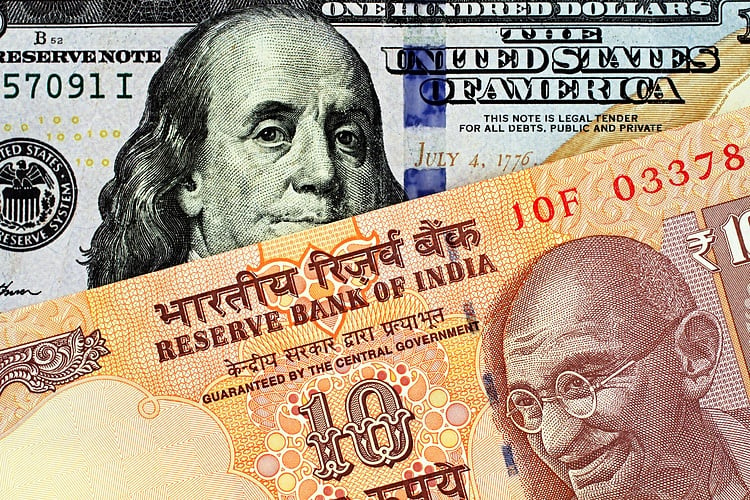Share:
Indian Rupee holds positive ground amid the softer US Dollar. Sustained dollar demand from state-run and foreign banks, overseas outflows, and higher crude oil prices might cap the INR’s upside. The FOMC Meeting Minutes will be in the spotlight on Tuesday.
Indian Rupee (INR) recovers some lost ground on Tuesday on the decline of the US Dollar Index to the lowest level since late August. On Monday, the Indian Rupee ended lower, matching its record closing low of 83.34 as a decline in the US Dollar (USD) offset the impact of higher crude oil prices. According to S&P Global Ratings, the Indian economy would be somewhat less influenced by global uncertainties owing to the country’s domestic orientation.Nonetheless, the renewed dollar demand from state-run and foreign banks and foreign funds outflows might exert some selling pressure on the INR in the near term. Market players will monitor the Federal Open Market Committee (FOMC) Meeting Minutes on Tuesday, which might offer hints regarding future policy rate direction and inflation improvement amid the quiet day in terms of economic data releases.
Daily Digest Market Movers: Indian Rupee remains under pressure amid mixed global cues India will be a $7-trillion economy by 2030 if the present growth trajectory is maintained, chief economic advisor (CEA) V. Anantha Nageswaran said on Saturday. Increasing crude oil prices, foreign funds outflows, and weakness in domestic equities weighed on Indian investor sentiments. According to a report in the Reserve Bank of India’s (RBI) monthly bulletin, the momentum of change in India’s GDP is estimated to be higher in October-December due to “ebullient” festive demand. According to the RBI, the Indian economy is expected to grow at a 6.5% annual pace between 2023 and 2024. The International Monetary Fund (IMF) has estimated growth of 6.3% every year until 2028. RBI is anticipated to maintain the policy rate during its upcoming monetary policy meeting scheduled for December 6-8. The India’s Consumer Price Index (CPI) climbed by 4.87% YoY in October versus 5.02% prior, above the market consensus of 4.80%. The US October leading indicator dropped 0.8% MoM from the previous reading of 0.7% MoM fall, the Conference Board revealed Monday. Investors anticipate the US Federal Reserve (Fed) to begin to cut the rates around the middle of 2024. According to CME’s FedWatch Tool, money market futures have priced in 50% chance of a rate cut of at least 25 basis points (bps) by May 2024.
Technical Analysis: Indian Rupee keeps the positive outlook The Indian Rupee trades firmer on the day. The USD/INR pair has traded within a range of 82.80–83.35 since September. Technically, the USD/INR maintains a bullish bias as the pair holds above the key 100-day Exponential Moving Average (EMA) on the daily chart. This outlook is supported by the 14-day Relative Strength Index (RSI) holding above the 50.0 midline.The upper boundary of the trading range of 83.35 acts as an immediate resistance level for the pair. Any follow-through buying above 83.35 will pave the way to the year-to-date (YTD) high of 83.47. The next upside target is seen at a psychological round figure at 84.00.On the flip side, an initial support level for USD/INR is located near the confluence of the lower limit of the trading range and a low of September 12 at 82.80. A decisive break below will see a drop to a low of August 11 at 82.60, en route to a low of August 24 at 82.37.
US Dollar price in the last 7 days The table below shows the percentage change of US Dollar (USD) against listed major currencies in the last 7 days. US Dollar was the strongest against the Canadian Dollar.
Indian Rupee FAQs The Indian Rupee (INR) is one of the most sensitive currencies to external factors. The price of Crude Oil (the country is highly dependent on imported Oil), the value of the US Dollar – most trade is conducted in USD – and the level of foreign investment, are all influential. Direct intervention by the Reserve Bank of India (RBI) in FX markets to keep the exchange rate stable, as well as the level of interest rates set by the RBI, are further major influencing factors on the Rupee. The Reserve Bank of India (RBI) actively intervenes in forex markets to maintain a stable exchange rate, to help facilitate trade. In addition, the RBI tries to maintain the inflation rate at its 4% target by adjusting interest rates. Higher interest rates usually strengthen the Rupee. This is due to the role of the ‘carry trade’ in which investors borrow in countries with lower interest rates so as to place their money in countries’ offering relatively higher interest rates and profit from the difference. Macroeconomic factors that influence the value of the Rupee include inflation, interest rates, the economic growth rate (GDP), the balance of trade, and inflows from foreign investment. A higher growth rate can lead to more overseas investment, pushing up demand for the Rupee. A less negative balance of trade will eventually lead to a stronger Rupee. Higher interest rates, especially real rates (interest rates less inflation) are also positive for the Rupee. A risk-on environment can lead to greater inflows of Foreign Direct and Indirect Investment (FDI and FII), which also benefit the Rupee. Higher inflation, particularly, if it is comparatively higher than India’s peers, is generally negative for the currency as it reflects devaluation through oversupply. Inflation also increases the cost of exports, leading to more Rupees being sold to purchase foreign imports, which is Rupee-negative. At the same time, higher inflation usually leads to the Reserve Bank of India (RBI) raising interest rates and this can be positive for the Rupee, due to increased demand from international investors. The opposite effect is true of lower inflation.
